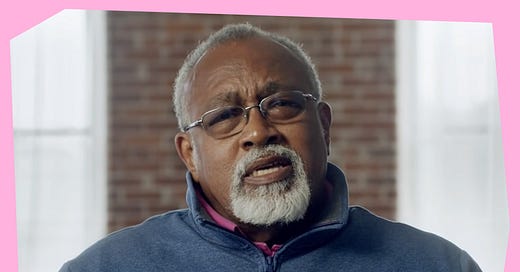Grow: How Glenn Loury grew a community of 20% paying subscribers through consistency and a clear scope
This is the continuation of our Grow interview series, designed to share the nuts and bolts of how writers have gone independent and grown their audiences on Substack.
We invited writer, academic, and podcaster Glenn Loury, who writes an eponymous newsletter, Glenn Loury, to share his insights on how he started making a living from Substack, expanding his community into thousands of paying subscribers. He shares his journey of migrating from other platforms, creating a consistent content strategy, developing a unique voice in a key ideological space, and continuous creative experimentation.
This interview has been lightly edited for length and clarity.
What’s your Substack about in one sentence?
My beat is race and inequality in the U.S., and I primarily cover it in conversations with other public intellectuals, most notably my bi-weekly co-host John McWhorter of Columbia University.
What do you offer readers and listeners?
In terms of value, my subscribers will find intelligent commentary on current events, rooted in decades of experience as an economist and public intellectual; sustained critique of the woke movement, which I see as dangerous to human civilization and bad for the soul; an example of civilized debate and conversation, strengthened by an ability to articulate not only my own position but also that of my interlocutors; and sense of community, through Q&As, exchanges in the comments section, and Mailbag issues of the newsletter.
And in terms of content, I publish a weekly podcast, in video and audio form with video excerpts with transcripts, I share original writing and audio monologues, occasional guest posts, public email exchanges with and between audience members, and monthly Q&As with John McWhorter and me, available to paying subscribers. I shoot for continuous creative experimentation.
I’ve been expanding the range of topics and formats I cover since coming to Substack. In addition to posts on race and inequality, I've been publishing autobiographical essays (The Double Life), math puzzles (Beautiful Ideas) and speculations about the coming AI dystopia (AI News from China).
Through subscribing to my newsletter, I also offer an opportunity to do some good: we donate 10% of our proceeds to worthy grassroots causes through the Woodson Center.
I aim to offer a broad mix of entertaining and illuminating content.
Growth by numbers
Started Substack: January 2021
Offered paid subscriptions: June 2021
Total subscribers: 19,000
Paid subscribers: 3,500
Why did you decide to go paid?
I had been monetizing the podcast through Patreon since the fall of 2020. Making the show profitable allowed me to invest in better recording equipment and hire a small staff and, secondly, feel more secure in my professional future. If, for whatever reason, the institutions I’m affiliated with stop paying me, I’ll still be able to make a living. Lessening my financial dependence on those institutions ensures that I can speak my mind without worrying that I’ll lose my livelihood.
Financially, I was doing just fine on Patreon. But it isn’t as well suited as Substack to publishing writing and engaging with the audience in the comments. Plus, with the newsletter growing, it made organizational sense to consolidate all of my content.
Lessening my financial dependence on those institutions ensures that I can speak my mind without worrying that I’ll lose my livelihood.
What’s your content strategy?
The backbone of my newsletter is the podcast. I started back in 2007. I record a new episode every week (every other week is with John McWhorter), which goes out to paying subscribers on Mondays and to the general audience on Fridays. In between these days, we publish video excerpts with transcripts.
I publish original posts twice a week. Wednesdays and Sundays are days when I publish original writing or audio monologues, letters from readers, various creative experiments I do with my team, guest posts by other intellectuals, and whatever else I decide to do in a given week.
I share clips from the podcast on YouTube. The video dimension is important because YouTube brings in new viewers through its suggestion algorithms. I launched my own channel in October 2021 and now have more than 30K subscribers; we post clips from the week’s episode there on Tuesdays and Thursdays. We also produce three shorter clips from each episode, which I publish on Twitter. In the past couple of weeks, we started experimenting with TikTok and YouTube Shorts.
What made you launch your podcast on Substack?
I had been publishing the podcast through Bloggingheads.tv and migrated to Substack after the newsletter had already become a success—this made sense organizationally, gave me more ownership of the feed, and allowed me to save money on hosting costs.
The crucial feature of podcasting on Substack is the ability to publish episodes for paying subscribers only (in my case, I release them to the rest of the audience five days later).
What’s the sharpest insight you can offer other writers about growing on Substack?
There’s not a one-size-fits-all solution, but this is what has been working for me:
I maintain a consistent schedule and have a clear model of growth. Subscriber benefits are very straightforward: early access to new episodes every week, a monthly Q&A, and occasional subscriber-only posts.
The content itself is not something you can find elsewhere. There just aren’t many high-profile black academics who occupy my ideological space, have my range of experience, and, frankly, have my ability to speak compellingly and extemporaneously.
I am on a mission—John and I jokingly call ourselves “Wokebusters”—and, to my listeners, supporting my work means helping this mission along.
I think of my readers and listeners as not just an audience but a community. They know I read their comments and reply when I can. They write me letters, and I publish some of them in the newsletter. They can ask John and me questions to be addressed on video. They also let me know when they think something isn’t working, which is just as valuable as praise. A portion of the money they pay goes to help grassroots causes around the country, and I know many of them feel good about that.
I also think the fact that the newsletter is constantly evolving, that we’re trying new things, must be a factor. It’s more exciting to support somebody who’s getting better and gaining momentum than somebody who’s stuck in their ways. We’ve got a good baseline strategy that ensures everybody gets what they paid for, and that gives us leeway to play around and see what the format is capable of.
I think of my readers and listeners as not just an audience but a community. They know I read their comments and reply when I can. They write me letters, and I publish some of them in the newsletter. They can ask John and me questions to be addressed on video. They also let me know when they think something isn’t working, which is just as valuable as praise.
What advice have you received about growing your publication that didn’t prove to be helpful?
I can’t think of one. What I’ve mostly heard is “Keep doing what you’re doing.” That said, I’ve been doing what I’m doing for a while now, and it will probably take less experienced writers a little bit of time to find their footing.
What has been a meaningful moment for the growth of your publication?
There wasn’t a single pivotal moment—I’ve had a sustained growth throughout the newsletter’s history—but local spikes do happen every now and again.
The most recent one—65 new paying subscribers in two days—was triggered by a publication of the video of a live TGS event we did at New York’s Comedy Cellar.
An earlier one happened when I published an autobiographical audio essay titled “The Double Life.” It comes to mind not so much because of the growth in numbers, but because of the incredibly positive feedback it received and the encouragement I got from it—which gave me inspiration to continue in the same vein (Call of the Tribe).
Both of these were experiments, both were successful, and I have plans for developing both of these directions further.
Top three takeaways
Be consistent with your output.
Get gradually better at what you do.
Make it interesting and meaningful for yourself—if you find an audience, it’ll be interesting and meaningful for them as well.
Who’s another Substack writer you’d recommend?
My creative director Nikita Petrov publishes a very imaginative illustrated newsletter called Psychopolitica. (I’ve been featured in two issues: Nightmare Journal, about the first days of the war in Ukraine and Nikita’s escape from Russia, and Glenn Loury Is Having a Terrible Thought, about the recent news of AI developments in China.)
What questions do you have for Glenn that we didn’t ask? Leave them in the comments!
To read more from this series on growing your publication, see our interviews with Erik Hoel, Jessica DeFino, Mike Sowden, Elizabeth Held, Jonathan Nunn, Polina Pompliano, Michael Williams, Judd Legum, and Caroline Chambers.










Share this post